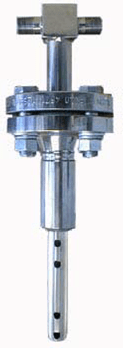Pitot tube sensors, orifice plates, flow nozzle or
venturi tubes are classified as flow measuring devices which utilize differential pressure
to measure volumetric flow.
Don't miss out on key updates, join our newsletter list here.
The Measuring Principle of Pitot Tube
The measuring principle of the pitot tube utilizes
the differences between the pressure ridge on the upstream side of a bluff body
and the static pressure on its down stream side.
We have differences in pressures at S2 and S1. This
difference in pressures is measured, then converted into fluid flow velocity,
from this we can derive the volumetric flow using the continuity law with a
pipe area A and an average flow velocity. i.e. Q=VA where Q is the volumetric
flow, V is the average velocity and A is the pipe area.
Required fluid conditions
To have good measurements from pitot tube sensors,
we need to satisfy the following conditions:
- The fluid has to completely fill the pipe so that the measured differential Pressure is representative of the volumetric flow. Fluids in partially filled pipes can only be measured if a full pipe can be arranged e.g. by means of siphon.
- The fluid must be single-phase. Two phase fluids e.g. water-air mixtures cannot be measured.
- The flow has to be sufficiently turbulent. Fluids of laminar nature cannot be measured with pitot tubes.
- Fluid may contain small particles or bubbles. The pressure generated in front of the sensor apertures causes a deflection of the particles or bubbles. Fluids which tend to crystallize will quickly plug the pressure tubes of the sensor and therefore cannot be measured with pitot tubes.
- In steam measurement applications condensate pots are used inside of which a constant transition from steam to condensate and vice versa occurs. The pressure transfer is achieved via water columns.
You can also read:
Industrial Applications of Pitot Tube Flowmeters
Pitot tube sensors are mainly used to measure the
volumetric flow of liquids, gases and steam in closed pipes ranging from½“ to
480“ (DN 20 to DN 12000).
Examples of specific applications include: Precise
volumetric flow measurement in batch processes, continuous measurement of
liquid ingredients in the process industry, fuel, air, steam and gases as
primary energy source as well as in control functions requiring a high degree
of stability and repeatability.
Advantages of pitot tubes over orifice plates
- They have a lower permanent pressure loss as compared to orifice plates.
- They have a shorter up/down straight pipe run requirements as compared to orifice plates.
- The profile of Pitot tube sensors is designed such that it is symmetrical to the plane between the pressure channels. This arrangement results in the same resistance values and thus the same k-factor with respect to the fluid properties during forward as well as reverse flow. The differential pressures generated by a given flow velocity are the same for flow in either direction. The only differ in the +/- sign. This constitutes an advantage of the orifice plate. Consider the figure below, of an orifice plate which because of its angled downstream corner has different resistances values for forward and reverse flows. It would indicate widely different pressures for the same flow velocity in opposite directions.
Some of the
manufacturers of Pitot tube flow measurement Instruments, include:
Don't miss out on key updates, join our newsletter list here.



No comments:
Post a Comment